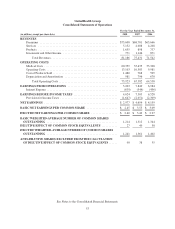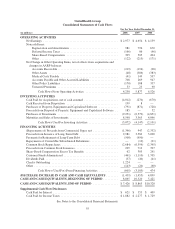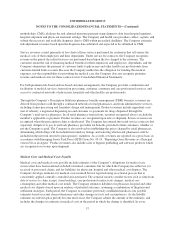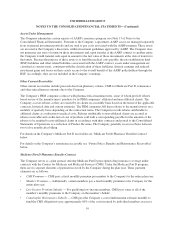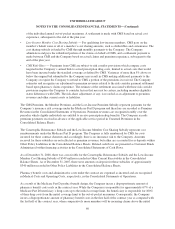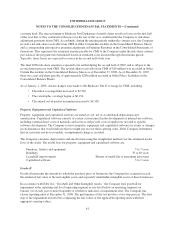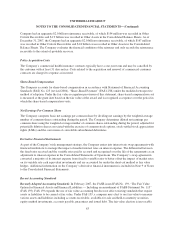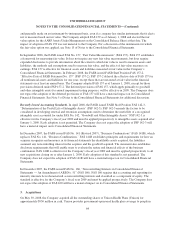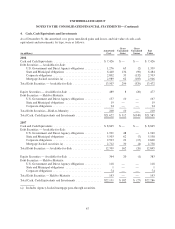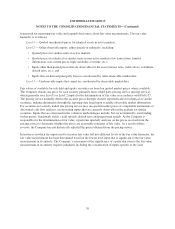United Healthcare 2008 Annual Report Download - page 73
Download and view the complete annual report
Please find page 73 of the 2008 United Healthcare annual report below. You can navigate through the pages in the report by either clicking on the pages listed below, or by using the keyword search tool below to find specific information within the annual report.UNITEDHEALTH GROUP
NOTES TO THE CONSOLIDATED FINANCIAL STATEMENTS—(Continued)
Company had an aggregate $2.0 billion reinsurance receivable, of which $154 million was recorded in Other
Current Receivables and $1.9 billion was recorded in Other Assets in the Consolidated Balance Sheets. As of
December 31, 2007, the Company had an aggregate $2.0 billion reinsurance receivable, of which $167 million
was recorded in Other Current Receivables and $1.8 billion was recorded in Other Assets in the Consolidated
Balance Sheets. The Company evaluates the financial condition of the reinsurer and only records the reinsurance
receivable to the extent of probable recovery.
Policy Acquisition Costs
The Company’s commercial health insurance contracts typically have a one-year term and may be cancelled by
the customer with at least 31 days notice. Costs related to the acquisition and renewal of commercial customer
contracts are charged to expense as incurred.
Share-Based Compensation
The Company accounts for share-based compensation in accordance with Statement of Financial Accounting
Standards (FAS) No. 123 (revised 2004), “Share-Based Payment” (FAS 123R) under the modified retrospective
method of adoption. Under the fair value recognition provisions of this statement, share-based compensation cost
is measured at the grant date based on the fair value of the award and is recognized as expense over the period in
which the share-based compensation vests.
Net Earnings Per Common Share
The Company computes basic net earnings per common share by dividing net earnings by the weighted-average
number of common shares outstanding during the period. The Company determines diluted net earnings per
common share using the weighted-average number of common shares outstanding during the period, adjusted for
potentially dilutive shares associated with the exercise of common stock options, stock-settled stock appreciation
rights (SARs) and the conversion of convertible subordinated debentures.
Derivative Financial Instruments
As part of the Company’s risk management strategy, the Company enters into interest rate swap agreements with
financial institutions to manage the impact of market interest rates on interest expense. The differential between
the fixed rates received and the variable rates paid is accrued and recognized over the life of the agreements as an
adjustment to interest expense in the Consolidated Statements of Operations. The Company’s swap agreements
converted a majority of its interest expense from fixed to variable rates to better offset the impact of market rates
on its variable rate cash equivalent investments and are accounted for under the short-cut method as fair value
hedges. Additional information on the Company’s derivative financial instruments is included in Note 9 of Notes
to the Consolidated Financial Statements.
Recent Accounting Standards
Recently Adopted Accounting Standards. In February 2007, the FASB issued FAS No. 159, “The Fair Value
Option for Financial Assets and Financial Liabilities — Including an amendment of FASB Statement No. 115”
(FAS 159). FAS 159 expands the use of fair value accounting but does not affect existing standards that require
assets or liabilities to be carried at fair value. Under FAS 159, a company may elect to use fair value to measure
various assets and liabilities including accounts receivable, available-for-sale and held-to-maturity securities,
equity method investments, accounts payable, guarantees and issued debt. The fair value election is irrevocable
63


